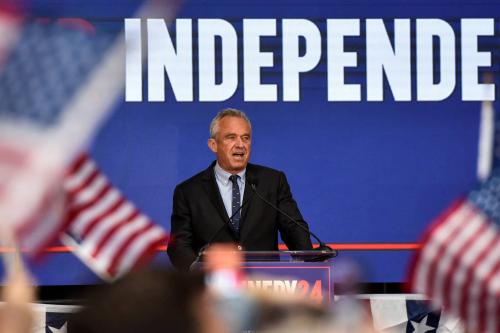The new Republican congressional majority faced a daunting challenge upon arriving in Washington late in 1994. To carry out their pledge to cut the federal government down to size, they had to pare back or wipe out the accretions of more than 60 years of liberal, distributive policy making and institution building. Recent Republican presidents, though vowing to slash taxes and snuff out federal programs, had mostly come to terms with the modern liberal state. The new Republican revolutionaries on Capitol Hill had no such intention.
They set about their mission through a tough-minded strategy of forging links with interest groups and the general public and, wherever possible, deconstructing their opponent’s political bases. As they waged war on federal aid programs, in many cases they cut of previously advantaged groups and advanced a new set of clients.
New Players, New Rules
Realizing that the established congressional committees were safe harbors for entrenched interests, the Republicans altered the operations of Congress accordingly. The most radical changes took place in the House. In naming House committee chairs—departing from seniority in four cases—Speaker-designate Newt Gingrich was, strictly speaking, acting beyond his authority. No one objected, however, and the Republican Conference readily strengthened the leadershipþs leverage over committee assignments. Chairmen were warned that their posts depended on their pledge to report out items from the Contract with America, even if they personally opposed them. Chairmenþs tenure was capped at three terms (the Speaker’s at four). Leadership staffs were augmented while committee staffs were cut.
House Republican leaders used leadership-dominated committees to shape legislation and keep the trains running on time. The Rules Committee aggressively recast legislation and selected amendments to be appended or made in order. Although technically curbing the “closed” rules Republicans so despised when they were in the minority, the GOP-controlled Rules Committee managed floor debate efficiently under special rules that are just as restrictive. To counter the tendency of standing committees to drag their feet and heed too closely their interest group clienteles, Republican leaders attached policy innovations to the time-sensitive budget reconciliation bill and entrusted action to the Budget Committee, which could act quickly as an arm of the leadership.
During the 104th Congress’s first hundred days, House committees were dragged on a forced march to complete action on the Contract with America. Often bypassing hearings or extended deliberation, they were rushed into action by the leadership to bring bills to the floor on time. At the first organizational meeting of the Government Reform and Oversight Committee, which had charge of five Contract items, Chairman William F. Clinger (R-PA) moved immediately from adopting committee rules to marking up a bill on unfunded federal mandates, on which no hearings had been held. “It was chaos,” Clinger admitted.
Republicans also adopted new rules and procedures aimed at strengthening party leadersþ management of the committees and reining in the autonomy enjoyed by committee leaders during the Democratic years. They began by establishing a tighter administrative chain of commandþfrom the leadership through the House Oversight Committee to the committee chairs. Within the committees, chairmen arrange the subcommittees, select chairmen, and hire staff members. Committees were asked to absorb 30 percent cuts in budgets and staff. The distinction between statutory and investigative staff members was eliminated, with committees no longer automatically entitled to 30 of the former.
To orchestrate committee processing of key legislation, leaders made creative use of multiple referrals, including a new type, “additional initial referrals.” In such referrals, the Speaker designates a primary (“lead”) committee of jurisdiction and decides whether, when, and how long other committees will consider the legislation. Eleven committees considered the budget reconciliation package; the same number, the bill to dismantle the Commerce Department.
Prestige committees were stacked with junior members, mostly Contract loyalists. Six freshmen were placed on Appropriations, six on Budget, three on Ways and Means, and one on Rules. Appropriations subcommittee chairmen agreed (in writing) to their removal if they failed to follow the GOP Conference agenda. These steps brought unaccustomed partisanship to Appropriations subcommittees and expedited unprecedented numbers of “riders” (limitation amendments) to implement the party’s policy goals.
To write high-priority legislation, GOP leaders often bypassed the committee structure entirely, using leadership committees (especially Budget and Rules) or ad hoc task forces, sometimes with the Speaker or Majority Leader personally overseeing the negotiations. When the Freedom to Farm Act was halted in the Agriculture Committee by opposition from influential interests (rice, peanuts, sugar), Speaker Gingrich, Majority Leader Dick Armey (TX), and Majority Whip Tom DeLay (TX) wrote a letter to Chair Pat Roberts (KS) threatening to bring the bill to the floor under an open rule, a step that would essentially strip the committee of control over the billþs fate. Then a leadership e-mail message was leaked contemplating reprisals against the committee recalcitrants. In the end, the leadership simply pulled the plug and let the Budget Committee write a farm bill “with true reforms.”
The pattern was often repeated. GOP leaders issued directives to committee chairmen on such disparate subjects as legal services, defense appropriations, banking reform, tax provisions, telecommunications, and District of Columbia government. “You can’t depend on the committee system to make bold changes,” explained Rules Chair Gerald B. H. Solomon (NY). “The leadership needs to pick up the slack.”
Finally, House and Senate leaders often used task forces to counterbalance the standing committees. No one knows how many task forces exist; one count late in 1995 found 35 in the House. The most conspicuous example was the eight- member “design team,” chaired by the Speaker, that crafted the partyþs Medicare proposal over the objections of Chairmen Bill Archer (TX) of Ways and Means and Tom Bliley (VA) of Commerce. Task forces often engaged in such competition with the standing committees, whose members, staffs, and allied interests were hard pressed to cope with novel, unfamiliar groups of players.
Some observers, noting Speaker Gingrichþs fascination with “third wave” (post-industrial) management, believe that he would like to replace traditional committees with more fluid arrangements. That may overstate his intentions, but certainly task forces suit his immediate legislative goals. Task forces are informal and short on rules, staff, and press coverage; friendly lobbyists are easily invited to the table, while opposing groups can be excluded.
Changes in committee structure transferred power from Democratic-oriented interests to those linked with the Republicans. When Democrats ruled on Capitol Hill, groups like the AFL-CIO, the Sierra Club, or the Childrenþs Defense Fund were favored; now the insiders are groups like the Family Research Council, the National Federation of Independent Business, and conservative advocacy shops like the Heritage Foundation or the Cato Institute.
Given an ambitious agenda and a deficit of expertise—hordes of inexperienced members served by staffs that were often equally green—it was perhaps inevitable that Republicans turned to friendly lobbyists to help draft legislation. Group agents infiltrated the deliberative process more blatantly than under the Democrats: they sat on the dais during committee sessions, they screened prospective witnesses, and they briefed reporters on legislation they drafted.
Like the Democrats, Republicans have shaped their key legislation, including tax provisions, tort reform, Medicare, welfare reform, and telecommunications, to meet interest group demands. In drafting the Clean Water Act, for example, the Transportation Committee called on the Chemical Manufacturers Association and other business groups, while pointedly excluding environmental and consumer groups. During committee work on welfare reform, Republican governors and their agents were much in evidence, while traditional welfare advocates were mostly sidelined. The nation’s largest provider of welfare services, Catholic Services USA, fought to testify before the Ways and Means Committee but was scheduled at night after most members had departed.
Defunding the Left
House Republicans were unblinkingly partisan when it came to loosening the liberals’ hold on the committee system. By tradition, of course, committee staff
ratios (approximately two-thirds for the majority, one-third for the minority) were reversed in both chambers. Eliminated were three committees with mainly Democratic constituencies District of Columbia, Post Office and Civil Service, and Merchant Marine and Fisheries. Left alone were the Small Business and Veterans’ Affairs panels, whose powerful constituencies were closely allied with the GOP.
The new regime also marginalized legislative service organizations (LSOs), which had occupied House office space and procured staff and supplies with members’ pooled funds. Liberal groups were especially enfeebled. The 28 LSOs included 11 liberal and 11 industry or regional groups, 2 bipartisan state delegations, and 2 Republican and 2 Democratic groups. Among those defunded were the Democratic Study Group, the black, Hispanic, and women’s caucuses, and groups promoting the arts, the environment, human rights, arms control, and federal employees.
Republicans have also tried to restrict “political advocacy” by federal agencies and non-profit groups paid to run government-sponsored programs. Although these groups cannot use federal money to influence the government, conservatives contend that they commingle public and private funds to subsidize lobbying and political activity. Seeing most such groups as part of a liberal infrastructure, opponents vow to “hunt [them] down one by one and extinguish their funding sources,” according to Grover G. Norquist, a GOP strategist and Gingrich ally.
One proposal, by Senator Alan Simpson (R-WY), became law as part of the Lobbying Disclosure Act of 1995. It bars federal grants to large groups with a 501(c)(4) tax status, which covers such “lobbying machines” as the American Association of Retired Persons (AARP) and the Environmental Defense Fund.
A more extreme measure, pushed with leadership support by Rep. Ernest J. Istook (R-OK) and David M. McIntosh (R-IN), covers an even larger category of charitable 501(c)(3) and 501(h) groups that receive federal money and spend more than 5 percent of their revenues on broadly defined advocacy. Although thus far dropped from pending bills, this proposal will surely surface again. It raises serious constitutional questions; civil libertarians and hundreds of non-profit groups, from the American Cancer Society to the Girl Scouts, have spoken against it. What is noteworthy about these proposals is their patent goal of limiting the effectiveness of groups associated with the post-New Deal liberal regime and of clearing the way for further pursuit of the new regime’s policy goals.
Unbuilding the Great Society
Will the new Republican regime endure? Can it dismantle the New Deal—Great Society regime? As the nave GOP freshmen discovered, it cannot be achieved overnight. It will take a few more election cycles before we can speak confidently of a Republican era. But the political tectonic plates are in motion. Republicans are now framing the policy agenda, forcing opponents to do battle on their own turf. And although many are claiming that the Republican revolution has stalled, just one year into the GOP-controlled 104th Congress President Clinton was trying to coopt conservative issues and proclaiming that “the era of big government is over.”
In a surprisingly short time, the new regime has transformed not only the content of policies, but the structures and rules through which they are made. But havenþt we always known that policy substance and policy processes are inevitably bound together?


Commentary
In with the GOP: Building a New Regime on Capitol Hill
March 1, 1996